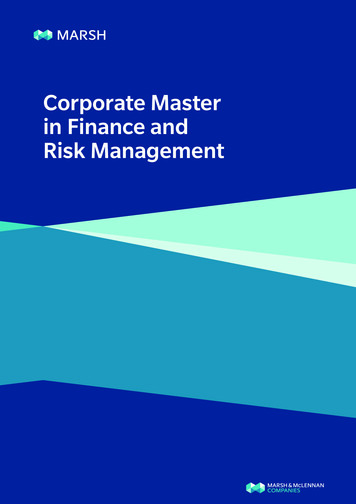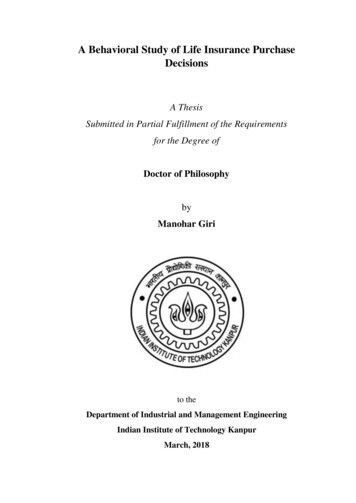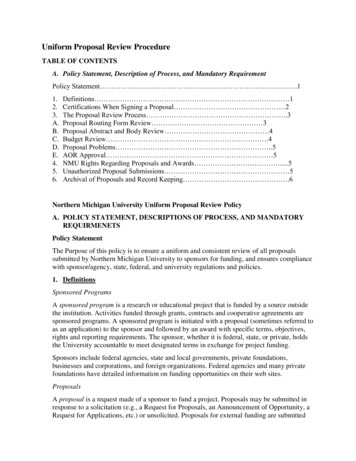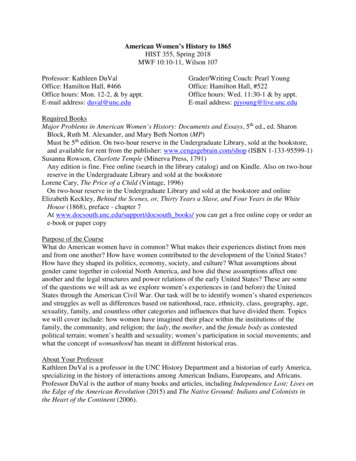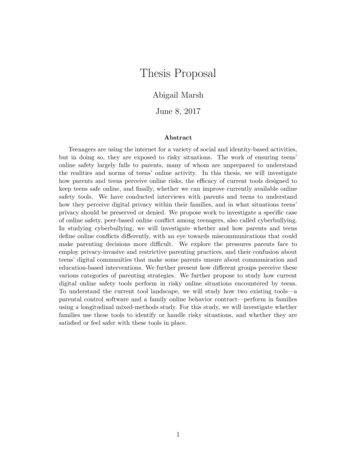
Transcription
Thesis ProposalAbigail MarshJune 8, 2017AbstractTeenagers are using the internet for a variety of social and identity-based activities,but in doing so, they are exposed to risky situations. The work of ensuring teens’online safety largely falls to parents, many of whom are unprepared to understandthe realities and norms of teens’ online activity. In this thesis, we will investigatehow parents and teens perceive online risks, the efficacy of current tools designed tokeep teens safe online, and finally, whether we can improve currently available onlinesafety tools. We have conducted interviews with parents and teens to understandhow they perceive digital privacy within their families, and in what situations teens’privacy should be preserved or denied. We propose work to investigate a specific caseof online safety, peer-based online conflict among teenagers, also called cyberbullying.In studying cyberbullying, we will investigate whether and how parents and teensdefine online conflicts differently, with an eye towards miscommunications that couldmake parenting decisions more difficult. We explore the pressures parents face toemploy privacy-invasive and restrictive parenting practices, and their confusion aboutteens’ digital communities that make some parents unsure about communication andeducation-based interventions. We further present how different groups perceive thesevarious categories of parenting strategies. We further propose to study how currentdigital online safety tools perform in risky online situations encountered by teens.To understand the current tool landscape, we will study how two existing tools—aparental control software and a family online behavior contract—perform in familiesusing a longitudinal mixed-methods study. For this study, we will investigate whetherfamilies use these tools to identify or handle risky situations, and whether they aresatisfied or feel safer with these tools in place.1
Contents1 Introduction32 Thesis Statement43 Background and Related Work3.1 Teen behavior and associated risks . . . . . . . . . . . . . . . . . . . . . . .3.2 Parent interventions: monitoring, motivation and fallout . . . . . . . . . . .3.3 Communication, education, and teen-led online safety . . . . . . . . . . . . .45694 Previous Work4.1 Parents’ and teens’ perspectives on privacy in a technology-filled world . . .4.2 Experts’ views on digital parenting strategies . . . . . . . . . . . . . . . . . .4.3 “How can parents monitor all that?”: Parents’ and teens’ views on digitalparenting strategies . . . . . . . . . . . . . . . . . . . . . . . . . . . . . . . .1010125 Ongoing and Future Work5.1 Understanding perceptions of online bullying and conflictfrom parents and teens . . . . . . . . . . . . . . . . . . . . . . . . . . . . . .5.2 Understanding the privacy and safety tradeoffs of digital risk-mitigation toolsfor families . . . . . . . . . . . . . . . . . . . . . . . . . . . . . . . . . . . . .146 Sample Table of Contents187 Timeline182131416
1IntroductionAdolescence is a period wherein teenagers begin to explore sense of self, and much of thisidentity construction is happening online for modern teens [10]. Parents are the first defenders of their children’s online safety, but they are often unsure how to guarantee thatwell-being [12]. There are many online sources, such as monitoring software providers [4]and journalists [19, 23, 49, 51], that encourage online safety practices such as monitoringteens’ online behavior or significantly restricting allowed behavior. But research shows thatthese parenting practices lead to distrust and lessened communication from teens, and canresult in teens hiding their behavior from their parents [27, 34, 39, 59].Existing digital parenting tools frequently encourage parents to prioritize teens’ onlinesafety over teen privacy. A recent paper, by Wisniewski et al., analyzed the features of 75Android mobile apps designed to help teens stay safe online. The authors found that thoseapps were targeted at parents for monitoring or restricting teens’ behavior; considerablyfewer apps offered any self-regulation features for teens, and those that did relied heavily onoptions for the teen to reach out for help from an adult [52].Some parents might choose instead to avoid tension between themselves and their childrenby allowing the child to have unmonitored, unrestricted access to the internet. Childrenof current generations have been called “digital natives,” and are assumed to be able tonavigate the risks of interacting with other people online fine on their own [43]. However,other researchers dispute the idea the “digital native” generation is naturally able to handleonline risks without ever receiving adult guidance [8]. Further, boyd has reported that theskill sets needed to navigate online risks may be unequally distributed across demographicfactors and individual access to digital devices [10], indicating that simply growing up in anage of ubiquitous computing is not enough for children to learn how to avoid risky situationsonline.Parents concerned with their childrens’ online safety are choosing from a set of optionsthat are often frustrating and unfulfilling for both parent and child. However, experts suggestthat parenting a child’s online behavior does not need to be these things. In past interviewswith experts, we have found support for monitoring practices, which experts say encourageparents to be attentive to their children [29]. Experts in this study also suggest that parentscommunicate with their children about online safety to encourage mutual respect and createan open dialog [29]. In this work, we examine parenting strategies to understand how theycan be improved for the benefit of both parents and children. We will accomplish this byexamining the outcomes of using current digital parenting strategies to set boundaries forchildrens’ online behavior, something not covered in existing literature.This thesis will investigate the current dilemmas facing families, including qualitativestudies of what frustrates or confuses them, and why current interventions are failing toaddress those frustrations. This work proposes to study a specific online risk, cyberbullying,to understand how parents and teens perceive the risk and whether their perceptions differ.This thesis also proposes a study to investigate how current interventions function whenteens encounter a risky situation online. This study will examine how families resolve thoserisky situations, and how parent and child feel about that resolution.3
2Thesis StatementThis thesis will investigate how we can improve adolescent online safety tools so that theyboth encourage teens to avoid risky online behavior and provide tools for parents that areless invasive of teens’ privacy. We will investigate how families with teenage children setboundaries and expectations for teens’ digital behavior and how current online safety toolsperform in parent-teen conflict situations to further this goal.Understand parents’ and teens’ perspectives on teen digital behavior.This thesis will employ interviews and surveys to understand how parents and teens negotiateappropriate boundaries for teen digital behavior and parental intervention. As detailed inSection 5.1, we will survey parents and teens about online bullying to understand whetherthere are differences in how both groups evaluate the severity of teen online conflict. Further,in Section 5.2, we detail a study that will investigate parents’ and teens’ reactions in realsituations of conflict or online risk.We will also draw from past work for qualitative accounts of these boundaries and conflictsin practice and to categorize common types of parental intervention. In Section 4.1, wereport an interview study with parents and teens that formed our first understanding ofcommunication gaps between the groups. In Sections 4.2 and 4.3, we report studies inwhich we built a categorization of parenting strategies, based on interviews with experts,and a survey in which we examined parents’ and teens’ perceptions of these categories. Wewill use this information to inform design decisions for a tool that encourages parent-teencommunication as a method to work through these disagreements.Understand family experiences of existing digital parenting tools.We will use interviews and surveys to investigate a highly-rated parental control softwareand an online behavior contract supported by the National PTA. Discussed in further detailin Section 5.2, we will conduct a study to examine the process of setting up these tools.Through interviews, we will look for usability concerns and learn how parents and teensnegotiate the decisions made about appropriate boundaries for teen digital behavior and forparental intervention. We will additionally investigate how the tools influence both parents’and teens’ behavior when the teen crosses one of the established boundaries or experiencessome online risks. Throughout these tasks, we will be observing whether using the toolencourages parents to look into teens’ private spaces or encourages alternative methods ofresolving the conflict.Additionally, we will survey a wider group of families instructed to use these tools. Thesesurvey data will provide a more sensitive measurement of changes in perception of onlinerisk and parental monitoring behavior.3Background and Related WorkTo investigate whether we can improve existing online safety tools aimed at adolescents andtheir families, we need to understand what teens are doing online and what existing research4
has already said about parent interventions. Below, we discuss work that covers teen onlinebehavior and the risks thereof, interventions based around monitoring and restrictions ofteen behavior, and interventions that rely on communication or education.3.1Teen behavior and associated risksMost teenagers are using the internet daily [25], and social media is their primary methodof communicating with friends [44]. In her book, It’s Complicated: The Social Lives ofNetworked Teens, danah boyd reports results from almost a decade of research and interviews.In that book, boyd writes that teens are socializing online because of new societal normsthat restrict teens’ mobility and access to public spaces [10]. The internet thus becomestheir connection to friends, entertainment, and the larger world.In the United States, teens have few legal protections online—the Children’s OnlinePrivacy Protection Act (COPPA) prevents data collection and distribution for children under13 without explicit permission from a parent or guardian [2]. The age restriction and parentalapproval process imposed by COPPA is a hassle for many families, however, and boyd et al.write that parents will help their children to lie about their age when registering an onlineaccount, in violation of COPPA [11]. Another law, the Children’s Internet Protection Act(CIPA), requires that schools and libraries receiving discounted internet access through agovernment program block online content that is obscene or harmful to minors [3]. This lawis more limited in scope, but is also more enforceable than COPPA, as it puts the burden ofaction on organizations rather than on families. The Child Online Protection Act (COPA),a precursor to CIPA that never took effect, was also intended to protect children from seeingsexual content online [1]. The law faced a decade of legal challenges from civil libertiesorganizations on the grounds that it restricted the free expression of adults who wished toview sexually explicit content, before being put to rest in 2009 [50]. Pornography laws also lieat the root of another current child online safety conflict. The broad nature of some existinglaws about child pornography intended to apply to adults has resulted in fear-mongering orlegal action taken against children who engage in consensual sexting that would have beenlegal if the sexual activities took place undocumented and offline [16].In a literature review, Marwick et al. [33] note the importance of studying teen privacyin relation to technology, given that much of teen socialization is online and that teenshighly value digital privacy. A Pew research report supports Marwick et al.’s conclusionthat teens take active steps to protect their privacy online: 60% of teens keep their onlineprofiles private, 74% have removed people from their friends list, and 26% have posted falseinformation to protect their privacy [28].In further research, Marwick and boyd found that teens used numerous ad-hoc methodsto preserve their online privacy. For one example, teens would couch posts in languagethat could only be understood by the intended audience [32], a finding also supported by aPew research report [28]. However, privacy is not always a motivating concern for teens, asMarwick and boyd also found that these teens engaged in privacy-risky behaviors, such aspassword sharing [32]. One survey found that 30% of teens are sharing passwords with afriend or significant other [26]. Significantly, Marwick and boyd write that teens engaged inbehaviors they knew to be privacy-risky and yet still held expectations of privacy in otheronline situations [32]. These results indicate that teens’ online behaviors are governed by5
complex and sometimes conflicting motications.Studies on teen health have examined how teens understand risky sexual behavior [13].Female teens revealed concerns about risk to be somewhat secondary to the powerful socialnormative forces driving sexual behavior among teens [13], similarly to how all teens areonly sometimes motivated by the previously mentioned privacy risks of online behavior.Pressure to engage in sexual behavior and concern about online privacy are two competingmotivations at play in the case of teen sexting [17].The motivations for taking the previously mentioned online risks may not be justifiable toadults operating in a different context. Research shows that parents do not always recognizeteens’ preferred privacy boundaries; in an interview study with 10 parents, Cranor et al.found that most of those parents did not consider teens texting friends and other onlinebehavior to be a private activity [12]. Similarly, parents may distrust and be inclined torestrict or monitor apps like Snapchat, which have a reputation as a place for sharing maturecontent. Despite this reputation, one survey of adult Snapchat users shows that most do notprimarily use the app for sexting [46].Further hampering parent-teen understanding about teens’ online behavior are parents’often inaccurate warnings about risks. Despite frequent media scares about sexting, manyteens feel like sexting is “no big deal” [24]; one study posits that sexting poses a significantrisk primarily to teens who are pressured into it [17]. Parents’ dire warnings about sextingmay exaggerate the likelihood of negative outcomes compared to the teen’s experience, leading teens to ignore even moderate warnings because they believe that the likelihood of allnegative outcomes are exaggerated.Marwick and boyd examine cyberbullying in another study. They report that teensdefine many online conflicts as drama. Teens define drama as an entertaining act that is lessserious than bullying [31]. This finding suggests that if adults approach “drama” behaviorsas bullying, teens might be unwilling to take adults’ advice. This could leave teens underprepared to navigate an escalation of this behavior.3.2Parent interventions: monitoring, motivation and falloutParents who go searching for information about monitoring software will find many sourcesthat support the use of these software tools. The parental control software providers have anobvious financial motivation to sell parents on their products. One provider supports parentalmonitoring by writing, “remember, it’s not spying, it’s parenting” [4]. The Chief ProductOfficer of another company is quoted in an article by The Washington Post encouragingparents to normalize potentially monitoring practices: “Set up ground rules as a familybefore you turn them loose. If you do that when they’re small, you don’t argue with a 16year-old about privacy. It will just be a part of your family at that point” [23]. A parentingand child development expert quoted in the same article may also have financial motivation:she is a speaker and author who makes frequent media appearances as a parenting expert.She suggests parents interpret child dissatisfaction as a sign of success: “[Teens] will tell youyou’re ruining their lives. and you will high-five your parenting partner” [23].Other popular press articles discuss the use of monitoring with more nuance, but theystill often suggest parents employ it. An article in The Christian Science Monitor quotesexperts who question whether monitoring software alone is sufficient to keep kids safe online.6
These experts argue that communication must underscore any parent’s approach, but thearticle goes on to quote additional experts that suggest parents should also be restrictingteens’ online activities [49]. An author in The New York Times discusses the proliferation offamily location-tracking technologies. The article is framed as a question: “Should you spy onyour kids?” The author establishes the privacy risks of location monitoring, quoting danahboyd and another Data & Society researcher. By the end, he suggests that the convenienceand safety of monitoring outweighs those privacy concerns, at least in many cases [51].Parents are seeking advice wherever they can find it, including writing to newspaperadvice columnists [19]. One parent writes in to The Washington Post:How old is old enough for teenagers to have “private” conversations on socialmedia? I feel like a snoop reading my 14-year-old’s conversations. However, Ifeel like a neglectful parent if I don’t. My child so far has handled herself well,but there have been some close calls (older boys urging her to play sexual gamesover Skype, etc.). We have a detente on my reading her stuff. I pretend I don’tand she pretends she doesn’t know I am looking.In response, the columnist calls on parents to monitor in moderation paired with a disdainfor privacy: “Any sense of privacy is false security, since anything texted or posted in privatecan end up everywhere” [19]. The thought goes, if corporations and untrustworthy friendscan violate your child’s privacy, why shouldn’t you?Parents are employing monitoring strategies in their families. According to a Pew surveyconducted in 2014 and 2015 of 1,060 parents of teenagers, most parents are monitoring insome form: 61% have checked which websites their teen visits, and 60% have checked theirteen’s social media profile. Almost half, 48%, have looked through teens’ phone calls ormessages. And 39% have used parental controls. Parents are also restricting their teens:65% have taken away a cell phone or internet privileges as a punishment, and 55% have timelimits on use [7].In peer-reviewed research papers, monitoring is treated skeptically. Mathiesen arguesagainst parental monitoring from an ethical standpoint in a literature review, asserting thatthough monitoring can be helpful in some cases to ensure teens’ online safety, they havea greater right to privacy that is more important than monitoring in most cases. Instead,she supports communication and negotiation between parents and children: “Parents andchildren can engage in democratic negotiation of mutual rights, trust and responsibilitieswith regard to using the Internet” [34].Newell, Metoyer, and Moore suggest in another literature review that both covert andovert monitoring likely furthers the distrust between parents and teens that it intends to address, citing work that shows children resist parental monitoring by developing countermeasures, and that children who are subject to environments with parental monitoring see thesame incidence of negative outcomes as those whose parents are completely uninvolved [39].They specifically condemn covert monitoring, writing:Covert monitoring by parents is first perceived as non-engagement by the child.Thus, if successful and never disclosed to the child, all of the risks of parentalnon-involvement are present. If covert monitoring is discovered, many of these7
adolescents will take counter measures (keeping two diaries, secret email accounts,etc.) and resist or defeat parental surveillance. .Moreover, there is now the issueof trust that must be considered by the child—discovered covert monitoring willlikely undermine the practice of two-way information sharing.One noted difficulty parents face when implementing monitoring is balancing it againstteens’ independence: in an interview of 10 parents, Cranor et al. found that their parentparticipants all felt that their children need on- and offline space to mature as they get older,but parents weren’t sure to what extent they should monitor children [12], and research hasso far not found what level of monitoring is effective. Parenting advice is difficult to prescribebecause of parents’ uncertainty, natural differences in parenting style [59] and ethical viewsof monitoring [35].Yardi and Bruckman write that teens’ privacy is often sacrificed for monitoring [59].Children’s awareness of parental privacy invasion starts young—in a qualitative study withchildren aged seven to eleven, Zhang-Kennedy et al. classified parents as one of four mainprivacy threats identified by their child participants. By contrast, the parents in their studyfocused on external threats to children and often relied on privacy-invasive parenting strategies to protect their kids, which were received with annoyance by the children [60]. Althoughconflict leads to negotiation about teens’ privacy rights, some research asserts that mandatory negotiation is damaging, stating “surveillance is a form of oppression” [10].Further, families that rely on monitoring for children’s online safety can also face difficulties if the family member who maintained those systems leaves the household. JenniferRode investigated security and privacy practices of 12 households in an ethnographic study,and wrote [45]:[T]he centralized nature of technical knowledge in these homes left children particularly vulnerable to security risks in the event of divorce of their parents orother such changes in domestic configuration.She also finds many examples of harms, ranging from parental access to childrens privatediary files and emails, to illiterate young children clicking through security warnings, to aparent who attempted to steal his sons identity for financial purposes. She calls for securityand privacy tools that account for the use cases represented by these households, and familiesmore generally, and urges the HCI community to study the tradeoff between childrens onlinesafety and their privacy [45].Even if parents think teens deserve some privacy, research shows that they often useparenting strategies that directly contradict those rights when trying to keep their children safe online [38]. For example, an interview study of 12 parent-teen dyads found thattechnologically inept parents favored restrictions that could result in a strangling of teens’social connections [57]. Conflict results when parents and teens disagree about teens’ privacyneeds [18, 42], or teens communicate less with their parents [18]. Researchers Livingstoneand Bober caution that the most privacy-invasive practices can strongly inhibit the growthof a positive, trusting relationship between parents and teens [27].In an interview with 16 parents of teens, Yardi and Bruckman caution that adults oftendo not understand teens’ online behavior norms well enough to create appropriate rules [59].8
In a survey of 249 parent-child dyads, Hiniker et al. investigated rule-setting around familytechnology use. They found that for both parents and children, context-based rules (e.g. notexting at the dinner table) were harder to follow through with than activity-based rules (e.g.child does not get a cell phone). They draw on related work to explain that people generallyhave a difficult time “unplugging from digital devices even when they know continued use isrude or unnecessary, and this seems to be the major factor inhibiting context-based rules [20].Faced with the question of how to impress the gravity of risky online behavior upon teens,many parents and educators also turn to fear as a motivator. Fear has shown to motivateadoption of cybersecurity tools in limited circumstances [22]. However, extensive surveys ofthe literature on fear appeals suggest that threatening and fear-based communication do notgenerally reduce risky behavior [41]. Also, fear appeals may lead people to control their fearabout risks by ignoring or denying the risk rather than by coping with the posed threat [58].In sum, prior research on fear appeals suggests that using fear to motivate teens not toengage in risky behavior may just push them to deny the risks, rather than dissuade thebehavior.3.3Communication, education, and teen-led online safetyStudies of online parenting groups focused on supporting parents of young children or childrenwith special needs emphasize the parent as the primary sharer [6, 47]. These children donot have the agency and reasoning power to make online privacy decisions, and researchin this area reasonably focuses on parental behaviors [37]. Further, the online presences ofyounger children are established and maintained by their parents, who thus make the privacydecisions for them [5]. However, teenagers have a degree of agency and autonomy not presentin most younger children, and can play a role in protecting themselves from online risks. Infact, Hiniker et al. found that children are more likely to follow rules for which the child hadsome input [20].Teens care about their online privacy and safety. A Pew survey shows that teens aretaking control of their online privacy, for example by limiting their online audiences [28].Marwick and boyd interviewed 166 teenagers, and note how teens are talking in codedlanguage, using slang, abbreviations, and allusions to communicate their private thoughtsto friends in plain sight on public accounts [32]. However, these independent initiatives posechallenges because many teens do not understand online privacy risks [36].One solution is to have those same monitoring and online safety software tools educateteens in addition to what they already provide for parents. A review of apps designed forteen online safety found a “staggering imbalance that favored parental control over teen selfregulation. This imbalance, in part, may be due to well-intentioned yet fear-based parentingstrategies aimed at keeping teens safe online” [52]. But, as discussed earlier, communicationrelying on threats or fear do not reduce risky behavior [41], and people respond to fearappeals by ignoring or denying risks, not addressing the threat [58]. These apps may be wellintentioned, but are unlikely to change teens’ responses to online risks without actionableadvice and education. The few apps that provided features for teens to take an active rolein their own safety offered primarily “reach out” features that connected the teen to theirparent; only a handful offered any self-monitoring or impulse control features that allowteens to address risks on their own [52].9
Parents could also talk to their kids about online behavior, as research shows that teensand parents are willing to discuss their concerns together when they share a positive relationship [48]. But Yardi and Bruckman found that many parents have trouble implementingauthoritative practices that are both demanding of and responsive to children [59]. In aninterview paper, Wisniewski et al. conclude that technologically literate parents are themost engaged with what their teens are doing online [57]. In a secondary analysis of 588teen survey responses, the same research group writes that these parents are also the mostsuccessful at keeping teens safe and preserving space for their growth [54].Evidence suggests that parents are talking about online safety with their kids. In aPew study, 40% of parents frequently discuss what is appropriate to share online, 39%frequently discuss what is appropriate to view online, and 36% frequently discuss what onlinebehavior towards others is appropriate. Notably, 56% of those parents reported frequentlydiscussing appropriate behavior offline. This gap between frequency of discussing online andoffline behavior suggests parents are struggling to find the most effective message for onlinebehavior [7].Blackwell et al. suggest that parents have limited visibility into teens’ device use—theycan tell if a teen is using a device at a glance, but not what they are using it for—whichobscures the many positive things teens are doing online. As a result, they found that someparents turn to restricting and monitoring because they doubt their child’s activities [9].A recent diary study found that due to a lack of common understanding between parentsand teens, parents consistently underestimate the frequency with which teens encounterrisky situations online. This communication breakdown exists in part, Wisniewski et al.state, because when teens tell their parents about these risky situations, parents respond bylecturing and punishing [55].However, online risks provide an educational opportunity for teens. In a secondary analysis of a Pew survey data set, Jia et al. found that teens are more concerned about theirprivacy after they have encountered a risky situation online [21]. Teens have also been foundto perform more risk-coping behaviors after encountering risky situations, demonstratingthat they are learning from past experiences [53], and some researchers suggest that low-riskexperiences may benefit teens by providing an opportunity to learn resilience [56]. Evenadults are largely unable to manage online
In her book, It's Complicated: The Social Lives of Networked Teens, danah boyd reports results from almost a decade of research and interviews. In that book, boyd writes that teens are socializing online because of new societal norms that restrict teens' mobility and access to public spaces [10]. The internet thus becomes




